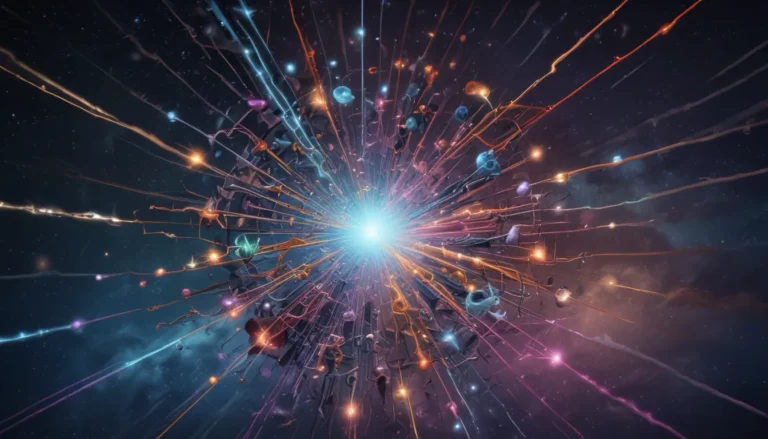The pictures we use in our articles might not show exactly what the words say. We choose these pictures to make you interested in reading more. The pictures work together with the words but don’t take their place. The words still tell you the important facts.
In the vast expanse of the universe, cosmic rays continuously shower our planet, carrying with them mysteries and valuable information about the cosmos. These high-energy particles, originating from sources such as supernovae and black holes, hold the key to unlocking the secrets of the universe. In the field of astrophysics, cosmic ray detectors have become indispensable tools for studying these particles and advancing our understanding of the universe as a whole. Let's delve into 14 intriguing facts about cosmic ray detectors, focusing on renowned detectors like AMS-02 and IceCube, and uncover the secrets they reveal about the cosmos.
Unraveling the Mysteries of Cosmic Rays
Cosmic ray detectors such as AMS-02 and IceCube play a crucial role in studying high-energy particles from space. These detectors are designed to detect and measure the intensity, energy, and direction of cosmic rays that continuously bombard the Earth from outer space.
The Alpha Magnetic Spectrometer-02 on the ISS
The Alpha Magnetic Spectrometer-02 (AMS-02) is a cutting-edge cosmic ray detector that was installed on the International Space Station in 2011. This collaborative effort involving scientists worldwide aims to study cosmic rays with unprecedented precision, leading to groundbreaking discoveries in the field of astrophysics.
IceCube: World’s Largest Neutrino Detector
Located at the South Pole, IceCube is the largest neutrino detector in the world, comprising a cubic kilometer of ice instrumented with optical sensors. It detects neutrinos, subatomic particles that offer valuable insights into cosmic rays and high-energy astrophysics.
Answering Fundamental Questions About the Universe
By studying cosmic rays, scientists hope to gain a deeper understanding of the universe's origins, the nature of dark matter, and the physics of high-energy astrophysical phenomena like supernovae and black holes. Cosmic ray detectors provide crucial data for exploring these fundamental questions about our cosmos.
- Cosmic ray detectors like AMS-02 and IceCube help scientists study space particles, dark matter, and solar activity, advancing our understanding of the universe and astronaut safety during space missions.
- AMS-02 and IceCube detectors have made groundbreaking discoveries, from confirming the existence of dark matter to detecting neutrinos from distant sources, pushing the boundaries of scientific knowledge and revolutionizing our understanding of the universe.
Unveiling Particles with Extreme Energies
AMS-02 and IceCube have detected cosmic rays with energies exceeding 100 trillion electron volts (TeV), providing valuable insights into the most energetic particles in the universe. These high-energy particles hold clues to the mysteries of cosmic phenomena and the composition of the cosmos.
Contributions to Antimatter Research
The AMS-02 detector has made significant contributions to antimatter research by providing valuable data on the presence of antimatter in cosmic rays. This research further expands our knowledge of the antimatter-matter asymmetry in the universe, shedding light on the fundamental forces at play in the cosmos.
Neutrino Detection from Distant Sources
IceCube's groundbreaking observation of detecting neutrinos from distant astrophysical sources has opened up new avenues for exploring the most energetic phenomena in the universe. Neutrinos provide a unique window into understanding the cosmic sources of these high-energy particles.
Studying Solar Activity and Its Impact
Cosmic ray detectors play a crucial role in studying solar activity and its influence on Earth. By monitoring cosmic rays, researchers can gain insights into the Sun's behavior, its impact on Earth's climate, and its effects on space weather and satellite communications.
Advancing Scientific Knowledge Through Data Collection
The AMS-02 experiment has been collecting data for over a decade since its installation on the ISS. This continuous data collection has led to numerous scientific discoveries and breakthroughs in the field of cosmic ray physics, expanding our understanding of the universe and its cosmic rays.
Deep Exploration in the Antarctic Ice
IceCube's detectors extend deep into the Antarctic ice sheet, providing a unique environment for studying neutrinos and understanding their properties. The interactions of cosmic rays with the Antarctic ice offer valuable insights into the composition and structure of the Earth's interior, aiding in geological research.
Ensuring Astronaut Safety in Space Exploration
By studying cosmic rays, scientists can assess the radiation hazards faced by astronauts during long-duration space missions and develop appropriate measures to safeguard their health. Cosmic ray detectors play a vital role in assessing astronaut safety and ensuring the success of space exploration missions.
Confirming the Existence of Dark Matter
The AMS-02 detector has contributed to confirming the existence of dark matter through precise measurements of cosmic ray particles. This discovery represents a major breakthrough in the field of astroparticle physics, shedding light on the elusive nature of dark matter in the universe.
Exploring Earth’s Interior through Cosmic Particles
IceCube allows scientists to study the Earth's interior by analyzing the interactions of cosmic rays with the Antarctic ice. This research provides valuable information about the composition and structure of the Earth's interior, offering insights into geological processes and Earth's evolution.
Pushing the Boundaries of Scientific Knowledge
Advancements in cosmic ray detector technology, exemplified by AMS-02 and IceCube, continue to revolutionize our understanding of the universe. These detectors push the boundaries of scientific knowledge, opening up new avenues for exploration and discovery in the realms of astrophysics and particle physics.
Conclusion: Embracing the Marvels of Cosmic Ray Detectors
In conclusion, cosmic ray detectors like AMS-02 and IceCube are indispensable tools for exploring the mysteries of the universe. These detectors provide valuable insights into cosmic rays, their origins, and their impact on our planet, shaping our understanding of the cosmos. Through continuous research and data collection, cosmic ray detectors pave the way for future discoveries and enhance our knowledge of astrophysics, particle physics, and cosmology.
FAQs About Cosmic Ray Detectors
-
Q: What is a cosmic ray detector?
A: A cosmic ray detector is a scientific instrument used to study and measure high-energy particles that originate from space. -
Q: How do cosmic ray detectors work?
A: Cosmic ray detectors work by detecting the secondary particles produced when cosmic rays interact with the Earth's atmosphere or other materials. -
Q: What is AMS-02?
A: AMS-02 (Alpha Magnetic Spectrometer-02) is an advanced particle physics detector installed on the International Space Station, studying cosmic rays to gain insights into dark matter, antimatter, and the origins of the universe. -
Q: What is IceCube?
A: IceCube is a neutrino observatory located at the South Pole, consisting of a cubic kilometer of ice instrumented with optical sensors to detect cosmic neutrinos. -
Q: What can we learn from cosmic ray detectors?
A: Cosmic ray detectors help scientists understand the origins and characteristics of cosmic rays, their energy spectrum and variations, and their relationship with phenomena like supernovae and black holes.
Embark on a fascinating journey through the realms of astrophysics and particle physics by exploring the wonders revealed by cosmic ray detectors like AMS-02 and IceCube. These detectors not only unlock the mysteries of the universe but also inspire us to delve deeper into the enigmatic cosmos that surrounds us. Embrace the marvels of scientific discovery and let your imagination soar as you unravel the secrets of the universe with cosmic ray detectors.






